COMMENT ON THE COMMENTS ON PART 14
A few readers said they appreciated my responses to comments on Part 13 so I do the same again for Part 14.
Bobo provided a link for Foxoles who said she’d like to read Part 13 again and asked where she could find it. In case she or any other reader has a similar difficulty again – my articles are an account of my sailing life in chronological order from 1995 onwards with some containing mini-accounts from a later time to illustrate a particular theme. There are several ways on the Going Postal Site in which links can be found. The two easiest are these – type the words ANCIENT MARINER in the SEARCH box on the GP Home Page – or – open any article and scroll down the box on the right hand side of the page until reaching the heading ARTICLES BY AUTHOR and then click on ANCIENT MARINER. Both methods bring up a page containing links to all my articles. I haven’t checked but suppose either method would also work for any other author.
The photo of the notice in the museum at Rodvig attracted general approval with some telling us they had seen the same notice in other places long ago. I hadn’t, so I make no apology for including it in my article and hope the description of it as Engleutsch was entertaining – I looked for an existing equivalent to Franglais but couldn’t find one.
In response to Betty Swollock’s remark she still didn’t know whether it was a good idea to tie oneself to the mast in an electrical storm or to Roger the cabin boy I definitely recommend avoiding the mast but imagine tying oneself to Roger might lead to an electrifying experience of a different type.
I need to explain for the benefit of El Cnutador that I have tried to draft a short piece on piracy and found it impossible to do justice to the subject as a digression in a longer article. Nor can I write about it in a light-hearted way because real life is not a musical comedy in the style of the Pirates of Penzance. People who have been murdered can’t talk about it, and those who have been captured and held hostage for ransom aren’t usually keen to do so. Even those like me who have had a dinghy or an outboard motor stolen whilst they have been asleep on board often want to avoid reliving the experience.
I think I’ll just give the topic a miss unless there are other readers who genuinely want to know more about what can happen, where it is most likely to be encountered and what responses can possibly be made to it. Written in that way there would be few illustrations and a review of the issues involved in carrying weapons on board would be included. The purpose of such an article would be to inform rather than to entertain and I usually try to do both. If El Cnutador’s repeated requests arise from a serious interest rather than a frivolous one and is shared by other readers I would be willing to have a go at producing a serious article.
I noted k3fsdetdfs was still puzzling over how a forward force on a yacht sailing into the wind can be generated by airflow over the sails and had found an article comparing a sail to an aeroplane wing – a comparison also mentioned in a bit more detail in Part 4 of this series. Mark Haywood suggested it would help to think of the yacht being sucked forward rather than pushed. Both explanations are opposite sides of the same coin, incompletely but more fully expressed in the following way – a differential pressure arises between air on the concave and convex sides of the sail/wing because of the different speeds of air flowing over each surface. Integrated over the entire surface of the sail/wing that creates a force on the sail/wing resisted at its points of attachment to the hull/fuselage. The resistance then passes the force on to the rest of the yacht/’plane and in the case of a yacht the resultant force is sufficient to overcome the resistance to movement of the hull through the water and on the mast, rigging and hull above the waterline from the air pressing aganst them. In the case of an aeroplane the wings are oriented horizontally so the upward force upon them is sufficient to overcome the weight of the ‘plane if it is flying fast enough.
An explanation of why there is a differential pressure on each face of the sail or wing takes a little longer. Mathematicians and Physicists have long tried to provide one. Leonhard Euler was the first to try and published his work in 1757. His analysis was followed by many others including studies by George Stokes and Claude Navier in the first half of the nineteenth century. These resulted in the so-called Navier-Stokes equations which are a way of applying Newton’s law that Force = Mass x Acceleration to fluids that takes into account the environment within which the fluid is contained and its own physical properties – environmental pressure, temperature, humidity, for example and fluid compressibility, density and viscosity. Many of these parameters are strongly interdependent on others so the equations are complex and a general solution has never been found. Doing so would win the finder a $ 1Million prize that is still available.
Theoretical solutions for simple shapes immersed in idealised, inviscid, incompressible fluids flowing at constant environmental pressure and temperature have been found. They constitute a first approximation to the behaviour of some fluids in smooth motion around “streamlined” solid objects and lead to the conclusion that “pressure + 1/2 density x velocity squared is constant” at all points within the fluid. If you now imagine an individual pocket of fluid being divided into two parts at the leading edge of an aerofoil shape it is easy to envisage the part travelling over the convex side has farther to go and needs to move faster than its mate moving over the concave side if the two are to smoothly re-combine at the trailing edge. You can then appreciate by virtue of the speed difference and the very simplistic formula for fluid behaviour that the pressure on the concave side is higher than that on the convex side.
I found it interesting, as mentioned in Part 4 of this series linked above, that the use of sails that improved the ability of ships to progress against the wind evolved empirically before any of this theory was developed – aerofoils for yachts came before aerofoils for ‘planes and cars though the word to describe their shape when the ropes were properly adjusted hadn’t been conceived at the time.
In the real world, the empirical approach is still used extensively in the search for solutions to practical problems like finding the best shape for an aeroplane wing, a car body, a crash helmet, a medical prosthetic and so on. These often take the form of placing models in fluid streams in air tunnels, wave tanks etc.
SOUTH EASTERN SWEDEN AND EASTERN DENMARK
The Soviet Union collapsed in 1991 and by the second half of the decade some adventurous yachtsmen had started to open up traditional cruising to St Petersburg and the Eastern Baltic including Russia, Estonia, Latvia and Lithuania as well as Poland and the former East Germany.
North Eastern Sweden and Finland had of course been politically open for some time so in theory a complete cruise of the Baltic would have been possible by 1997.
But, distances are long and the sailing season short, so I had compromised in making my plans and given priority to my original idea of circumnavigating the UK in a single season. That was still compatible with poking Alchemi’s nose into the near Baltic for three weeks in June and that’s what I had decided to do for the second leg of her 1997 cruise.

Here is a copy of the relevant map from my Journal, again with text showing through from the other side of the paper.
The reader will see the idea was to sail up Sweden’s south eastern coast as far as Kalmar and then return to Copenhagen via the Danish Island of Bornholm and its offlyer, Christianso.
COPENHAGEN
I was expecting one other companion to join me and was a little disturbed when that didn’t happen on the planned day but occupied myself by sightseeing in the city.
Copenhagen has several wide thoroughfares with the usual capital city throng of cars, commercial vehicles, buses, and so on. It also has some very attractive streets reserved for pedestrians. I was surprised when strolling around these by a troop of bearskin-clad soldiers in blue uniforms marching smartly along whilst wearing swords and carrying old-fashioned firearms. They went swinging through the crowds of shoppers to the beat of a pair of drums and the tuneful but rather shrill whistle of a piper. Danish pageantry may not quite match British but it comes a libertarian second.
As I returned to Svanemolle a taxi pulled up outside the yacht club and my expected crew member emerged after being detained in hospital overnight for a check-up on repairs to a head-wound, sustained during a mugging before leaving London. Another case of modern piracy for El Cnutador’s collection though carried out on land before embarkation.
GISLOVS LAGE, YSTAD AND SIMRISHAMN
The second leg thus began three days later than planned and Tuesday started as another of those fine Scandinavian days with a bright blue and cloudless sky. Deciding not to use the Falsterbro canal we rounded the southernmost point of Sweden under sail but for lack of wind had to motor to the small village of Gislovs Lage.
This was just a dormitory and quiet holiday base for the nearby town of Trelleborg and we moved on the next day to Ystad.

There were several foreign boats here and we admired the Najad 361 of a Dutch couple moored nearby. Their invitation to share coffee in the cockpit was soon extended to stronger refreshment below. After talking about ourselves and our yachts all evening the owner confided one of the problems with his boat was that it had too much Genever still on board. A problem we did our best to rectify before tottering back to Alchemi.
Despite the previous evenings excesses our Dutch friends were already leaving their berth at 08:00 the following morning but we strolled around the town before doing the same ourselves.
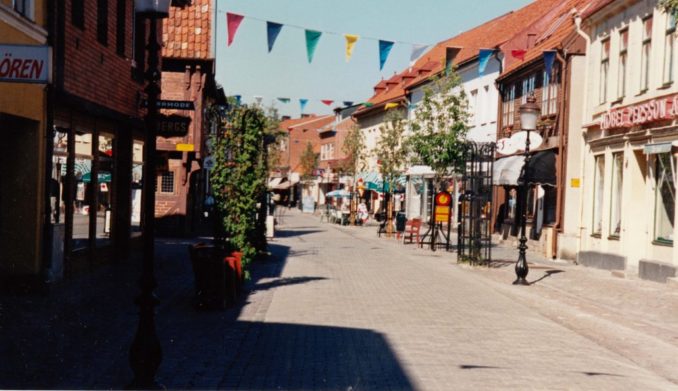
Later in the day we had headwinds the whole way to Simrishamn and ended up sailing 45 miles to cover the direct distance that was only 30. But interestingly, in this latitude, which is just south of Edinburgh’s, there was still enough light in mid-June to moor the yacht even though it was 11:00 at night by the time we arrived.
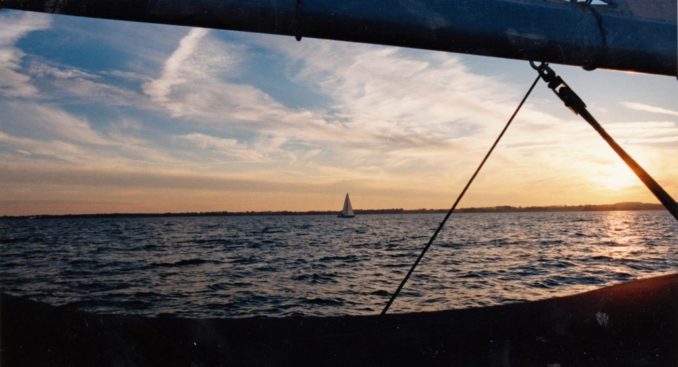
Simrishamn is a lovely little town with a large and well-protected harbour having an easy approach from the sea.
The town also has an excellent bookshop in which I was delighted to find a series of 15 very detailed yachtsmen’s charts of the coast from Oskarshamn to Ahus in a plastic folder providing easy access and great protection.
HALLEVIK and HANO (1)
Hallevik was notable for its very mixed community with two fishing co-operatives, a convention hotel hosting a large firm’s Sales Conference and many large and expensive-looking holiday homes with manicured gardens.
Also for a pub heaving with people listening to a four man pop band that charged about £ 6 for a half litre of beer – in 1997! Some had clearly imbibed too deeply but one such, who stopped and addressed us in Swedish asked in perfectly pronounced English whether we were familiar with the works of Queen and Radio Gaga when we responded to his greeting.
The small island of Hano was more interesting for two reasons.
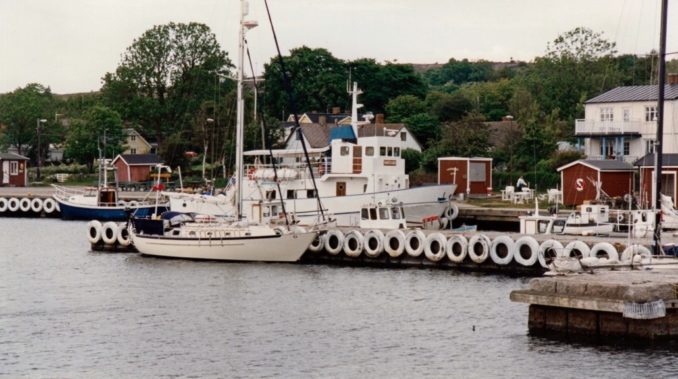
This was the first harbour at which I stayed that had a concrete wharf protected by a line of used tyres. This is in fact a common feature of many harbours around the world and is a real pain for small yachts with small fenders.
The problem is that the fenders can get caught in the central hole of a tyre and be held there as the yacht moves about as a result of swell, wind, the wash of passing traffic or tidal changes in height. Great forces are then applied to lines holding the fenders and safety wires around the deck from which they are often suspended. The problem can be mitigated by inserting a fender-board between the lines of fenders and tyres but then the end of the fender board can sometimes get stuck. At this time I was carrying a wooden ladder for use as a fender board so we often used that on this voyage.
Tides are not a problem in the Baltic because the range is always small but after we’d been for a walk on the island the swell was. A wind straight into the harbour entrance had developed and caused so much movement the harbour master and his wife helped us move the yacht into a quieter berth owned by a yachtsman who was away for a couple of days.
There was no opportunity to take photographs during that move but in my mind’s eye as I write this account I can still see the harbour-master’s wife anchoring one rope with legs and body braced against the load as if she were engaged in a one-woman tug of war – which in a way she was. This was another example of the practical friendliness of the Scandinavian people we met.
The other interesting fact about Hano is the existence on the island of an “English Cemetery”. Mentioning this gives me the opportunity for one of the Historical Digressions arising from investigations I liked to make whilst cruising to increase my understanding of the places and people visited.
HISTORICAL DIGRESSION
The Baltic was a very important theatre of Naval conflict during the Wars between Britain and France in the 1790s and early 1800s. One element of these was a major diplomatic effort by each side to secure or break-up alliances with third countries including Russia, Prussia, Denmark, Sweden and Norway.
Both France and Britain sought dominance of trade in the Baltic and particularly control over the supply of Scandinavian raw materials (perhaps that’s where Admiral Fisher got the idea from some 100 years later – by then it would have been a much more difficult task because of the construction of the Kiel Canal, as explained in parts 13 and 14 of these articles).
Russia persuaded Prussia, Sweden and Denmark to form a league of Armed Neutrality in favour of trade with both England and France but the British didn’t like that and sent a fleet to Denmark with Admiral Hyde Parker in charge and Vice-Admiral Nelson as his second in command. Parker’s orders were to “detach Denmark from the League by amicable arrangement or actual hostilities” to be followed by “an immediate and vigorous attack on Russia.
Parker wanted to avoid open warfare with the Danes whereas Nelson wanted to bypass them and Sweden and get on with fighting the Russians so the three countries could not collect all their forces together before battle began. The Danes rejected Parker’s diplomatic efforts so the British attacked the Danes in the First Battle of Copenhagen in 1801.
In the early stages three British ships ran aground and Parker, unable to see much of what was happening but thinking Nelson might need to retreat, flew a flag-signal calling for withdrawal. By popular account Nelson clapped a telescope to his blind eye and said “I do not see the signal”, and fought on to secure victory.
Nelson went on to win the battle of Trafalgar against a combined French and Spanish fleet in 1805 and that was followed by a blockade of French ports. Napoleon responded to that by insisting on a “Continental System” that forbade countries under his control or influence from trade with Britain.
In 1807 Denmark, now allied with Norway and again trying to remain neutral was heavily lobbied by both Britain and France to join sides with them, accompanied in the French case by a threat to invade Holstein (a province of Denmark at the time) if they did not. The Danes refused both approaches and were promptly attacked by the British to keep out the French.
That set the scene for Britain to maintain a large Baltic Fleet for the next few years and takes us back to Hano because it was on this small island in 1810 that a British naval base was built. It was from here that trade and smuggling with other Baltic ports was protected and encouraged.
Those activities, particularly in the Eastern Baltic was one of the factors leading to Napoleon’s decision to invade Russia in 1812 that led to the famous winter retreat, his abdication, and exile to Elba. (That was of course followed by his escape from Elba, second attempt to create a unified Europe under French control, and eventual defeat at Waterloo. But that period belongs to an account of Alchemi’s visit to St Helena in 2008.)
HANO (2)
Some accounts describe the number of sailor’s graves as “a few”; my journal mentions “10 or more” but I’m not sure if I arrived at that number by counting or from some other source. Wikipedia says there are 15 and all agree that the British navy erected a large cross on the site in 1972. British vessels patrolling in the Baltic still call there from time-to-time and hold a memorial service when they do.
I liked these reflections, and the sense of continuity with the past engendered by our visit.
KARLSKRONA
This city has a very protected harbour inside a chain of outlying islands and rocks both awash and just below the surface. I was very relieved to have available the charts I had bought at Simrishamn. We cautiously made our way past the Uddcomb factory I had visited on business many years before, and past the Naval Base about whose security the Swedes are so sensitive, to find the Karlskrona Sailing Club’s base at the northern end of the Dragso peninsula.
In the UK we tend to think of the “Vikings” and the “Danes” as a single homogeneous group of people because of their invasion of Saxon Britain. In fact there were many wars amongst them except for about 150 years following the Union of Kalmar in 1396 when it was agreed Norway, Sweden and Denmark would henceforth be a single country ruled by a Danish Monarch.
That didn’t last long and they were soon fighting one another again with control over what is now Southern Sweden (the original Scania of Roman times) alternating between the Danes and the Swedes. In the seventeenth century Denmark’s northern expansion from their base in Kristianopel was resisted by the Swedes in their strongpoint at Kalmar castle. The Danes retreated and built a castle at Karlskrona that became their capital for the region.
Although the Danes and a large population of German craftsmen were both Protestants they were from different sects so there are still two large churches, each of Cathedral size, in the same city square.
We also found a small private museum founded by an Italian family driven out of the Balkans during the recent wars. They must have been fabulously wealthy because the gallery included paintings by Leonardo, Breughel, Fragonard, Reni, Van Goch, Braque and other famous artists. Our appreciation of these was greatly enhanced by a very knowledgeable and enthusiastic curator who showed us around.
KRISTIANOPEL and KALMAR
Kristianopel may have been an important place in the seventeenth century but there is little sign of that now. Apart from the small harbour and an adjacent campsite there seems to be little more to it than a row of houses some two hundred yards long.
It did provide a new yacht mooring experience though. This harbour had a single pontoon but no piles at the outer end of its berthing spaces. Instead, one was required to lay a stern anchor some distance from the pontoon that was approached bow-to and secured to it with two lines in the normal way. This is sometimes called “Mediterranean” mooring because there are so many yachts and so little space in many marinas there that this technique is often required.
It requires good judgement when dropping the anchor far enough away from the pontoon to avoid it being pulled along the seabed as its cable is tightened, but not so far it constitutes a hazard to other craft as they move around the harbour. It was also undesirable sometimes in Alchemi with its narrowish and rounded stern because the cable could be pulled up against the self-steering gear’s support frame when there was a cross-wind or current.
Our first attempt here wasn’t perfect but at least the boat stayed in position overnight.
Upon arrival at Kalmar we were disappointed to learn most shops and attractions would be shut early on Friday afternoon and closed on Saturday and Sunday because it was a special holiday weekend.
We didn’t get to see the Cathedral, the interior of the Castle or a museum exhibiting the remains and contents of a seventeenth century naval ship that, like the Vasa and Mary Rose, had capsized when water rushed in through open cannon ports as the ship heeled during a tack.
My own photos of the castle were disappointing because of poor focus or camera shake so here’s one from Creative Commons.
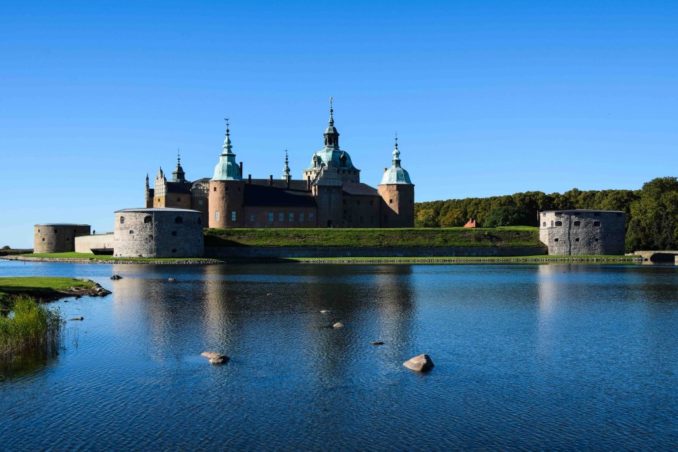
Kalmar was the northernmost city we had time to visit on this cruise so we set sail for the south on the longest day of the year. Sadly, there was little wind until the evening and we lost so much time in the afternoon that darkness was descending as we approached the small island of Utklippen. This is little more than a lighthouse on a bunch of rocks and we failed to find any buoys marking the channel to an anchorage mentioned in the pilot book.
Deciding to sail overnight we saw many large ships despite the heavy rain that set in around 03:00 because we were now on the shortest route between the North German ports, Stockholm and Finland.
CHRISTIANSO AND BORNHOLM
By early afternoon we were approaching the small Danish islands of Christianso and Frederikso just off the larger one of Bornholm.
Christianso has a small harbour that’s rather open and prone to the entry of swell. We had fun and games here when we had to move soon after rafting-up against a larger Dutch yacht that decided to leave almost as soon as we were settled. Soon after, we became the inner boat as a 39 foot German sail-training yacht rafted up on our own seaward side and young people started tramping over our decks as they disembarked and clambered back on board again.
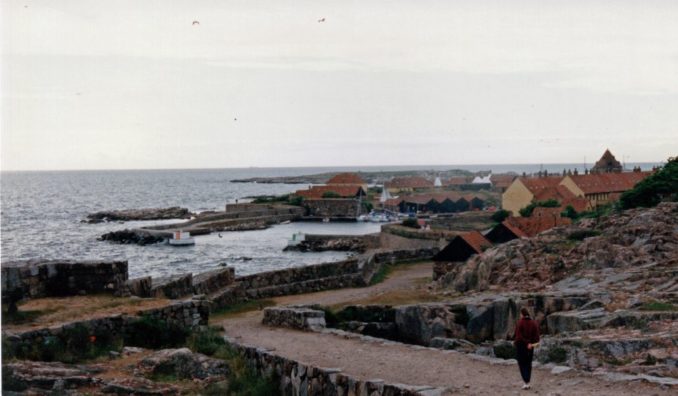
The late seventeenth century was a period when the Swedes were ascendant in their wars with the Danes, had recovered all of Scania and occupied most of the islands in western Denmark and besieged Copenhagen itself for 6 months. The siege of Copenhagen was effectively relieved by the Dutch as allies of the Danes who also held on to Bornholm and its nearby islands. During these wars Christianso was effectively converted into a large gun battery by building platforms like this one all around it.

It isn’t far from Christianso to Bornholm where we elected to stay at Hasle rather than the larger but more commercial harbour of Ronne.
We were struck by the very noticeable change of architectural style here. We were back in the land of single-story cottages fronting straight onto the roadside in place of the two and three storied buildings with bold fronts common in mainland Sweden.
Here we found our way to the local camping ground at which a mid-summer festival was in full swing. The celebrations were something like a Guy Fawkes night without the fireworks. A large fire was blazing on which a witch’s effigy had earlier been burnt. Even more amazing was a Danish guitar and banjo group playing Irish folk songs made popular by “The Dubliners” some years ago – but this time with the words in Danish! A wooden dance floor had been erected nearby and was being merrily pounded by young and old alike.
YSTAD AGAIN AND THE FALSTERBRO CANAL
Ystad is situated so conveniently we stopped again at the same marina but this time spent a whole day wandering around the town. Pride of place amongst its buildings was taken by the elegant Opera House.
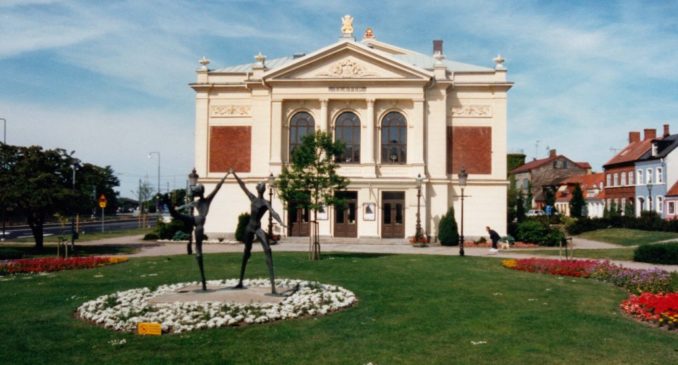
This was summer festival week and we enjoyed ourselves even more as we strolled around,occasionally leaping out of the path of an ancient fire engine now used to provide holidaymakers with a town tour.
Of special interest to yachting visitors was an Aladdin’s cave of a Ship’s Chandler located in a disused railway station where we bought a number of items including a specially shaped stainless steel hook used for stern mooring to buoys, and a genuine Swedish Sou’wester made in Portugal (I used both for many years after).
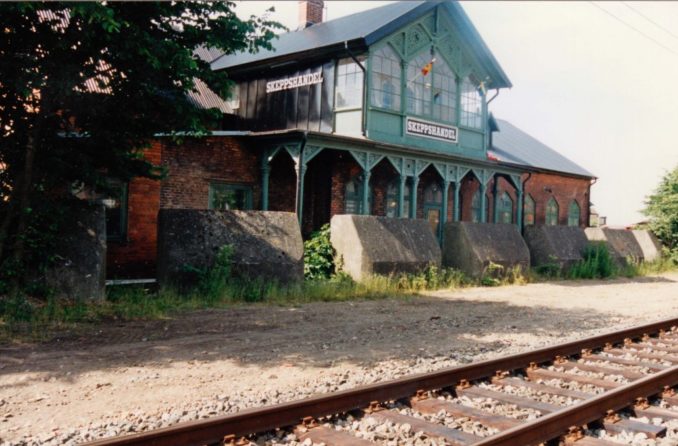
We had a fast sail back to Svanemolle marina in Copenhagen after a brief wait for road traffic to be halted and the bridge across the Falsterbro canal to be opened.

An exhilarating conclusion to this leg of Alchemi’s 1997 Voyage was achieved by sailing the 56 miles to Copenhagen in 10 hours.
To be continued …………….
© Ancient Mariner 2021
The Goodnight Vienna Audio file



